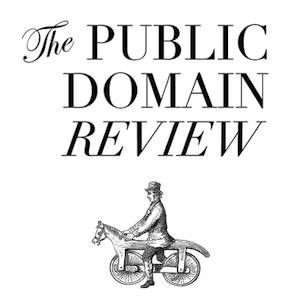
Sites We Like: The Public Domain Review
A place like Project Gutenberg is fascinating for its massive amount of material, true enough, but a place that curates and examines the world of public domain information is perhaps even more exciting. That’s what The Public Domain Review is, in essence, and I’ve been eating it up all week. It is a brilliant places which analyzes, discusses, and builds lengthy examinations of the world and its events and literature in the pre-1923 world of expired-copyright, open-to-everyone information. They regularly post articles which are the blend of history, biography and, thanks to additional reading and various links, an attempt to curate Project Gutenberg, among other places.
Articles
Every two weeks (that’s “fortnight” to you, chum) they publish a lengthy piece of text on a variety of historical subjects and pieces of literature. All of them which I’ve read so far have been fascinating. Some of my favorites have included Victorian Occultism And The Art of Synethesia, which talks about the interesting subject of expressing pieces of music and moments of people’s lives as pictures and movements of color through gray spaces, before wandering off to examine more nutty corners of Victorian Occultism (my favorite.)
Then there’s a very interesting look at The Memoirs of Joseph Grimaldi the Clown, a fascinating person who lived in the twin worlds of mirth and misery, who retired early, whose autobiographical notes were almost useless, and whose biography Charles Dickens rewrote into working order. I knew so little about Grimaldi before this article, apart from passing references in other texts from the time. I’m excited to learn more about him.
This one is probably my favorite, a look at The Lost World of The London Coffeehouse, a topic about which I knew nothing and which is fascinating. Did you know that coffeehouses lead to a tremendous boost in economy and social advancement partially because it gave a place for people to meet and network…but mostly because they were now drinking coffee instead of beer and thus were sober for the first time ever. Isn’t that great? Also, I don’t drink coffee now in Ye Moderne Times, but old-timey coffee sounds particularly terrible. Gritty and weird. It sounds like mashed-up, liquified acorns inna cup. I may not be far off.
That’s just the tip of the iceberg, too. There is a lot of reading waiting for you on the site. Right now, I’m reading a piece on Krakatoa Sunsets.
Film
I was pretty content with the excellent articles on their site, but then I wandered off and discovered they have films on their site too. A lot of film.

When not in Tramp makeup, Chaplin apparently looked like Cillian Murphy.
Here is the first film that caught my eye: The Temptation of St. Anthony, a film made in 1898 by George Melies. George Melies was one of the very first people to use film, one of the first to use it to tell stories, and one of the first to use special effects in telling those stories. It’s well over a hundred years old, but his films are still astonishing pieces of work. He’s a fascinating man. (And fun fact. He looked exactly like Ben Kingsley, who played him in the film Hugo which I am nuts about).
Here’s another one, called Making A Living, from the year 1914. What’s exciting about it is, as their page says, it’s the first film appearance of Charlie Chaplin. How exciting is that?? Pretty exciting, depending on how enthusiastic you are about Charlie Chaplin, and I am extremely enthusiastic. I’ve seen a lot of Chaplin’s work and read about him, but this was the first time I’d seen this particular film and I was very happy for it.
This next one is probably my favorite, though. Horse-Drawn Fire Engines from 1896. It’s only twenty seconds long and it’s not much more than the fire engines galloping past, but I love it because I love peering into other places and other times, even for just a few seconds. Everybody’s wearing black because color hadn’t been invented it so what else were they gonna wear?
…
This is just scratching the surface of what they have, and also scratching the surface of their categories. I didn’t even get into the audio sections, or the image collections they curate. You can find those yourself, though. Go on, rummage around. You can thank me when you emerge, bleary-eyed, a few weeks from now, entirely uncertain what year and century you’re actually in.



